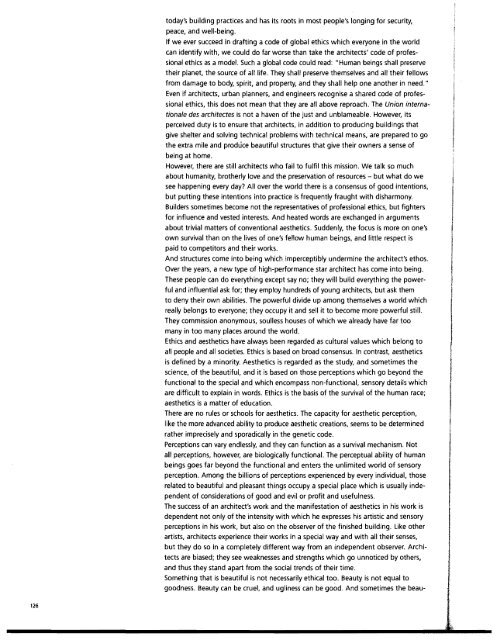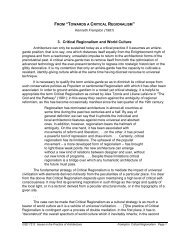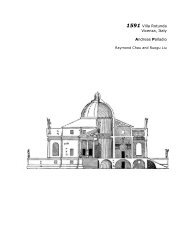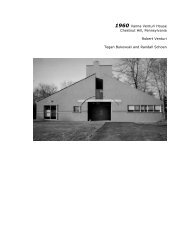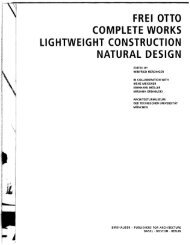frei otto complete works lightweight construction natural design
frei otto complete works lightweight construction natural design
frei otto complete works lightweight construction natural design
Create successful ePaper yourself
Turn your PDF publications into a flip-book with our unique Google optimized e-Paper software.
126<br />
today's building practices and has its roots in most people's longing for security,<br />
peace, and well-being.<br />
If we ever succeed in drafting a code of global ethics which everyone in the world<br />
can identify with, we could do far worse than take the architects' code of professional<br />
ethics as a model. Such a global code could read: .. Human beings shall preserve<br />
their planet, the source of all life. They shall preserve themselves and all their fellows<br />
from damage to body, spirit, and property, and they shall help one another in need."<br />
Even if architects, urban planners, and engineers recognise a shared code of professional<br />
ethics. this does not mean that they are all above reproach. The Union internationale<br />
des architectes is not a haven of the just and unblameable. However, its<br />
perceived duty is to ensure that architects, in addition to producing buildings that<br />
give shelter and solving technical problems with technical means, are prepared to go<br />
the extra mile and produce beautiful structures that give their owners a sense of<br />
being at home.<br />
However, there are still architects who fail to fulfil this mission. We talk so much<br />
about humanity, brotherly love and the preservation of resources - but what do we<br />
see happening every day? All over the world there is a consensus of good intentions,<br />
but putting these intentions into practice is frequently fraught with disharmony.<br />
Builders sometimes become not the representatives of professional ethics, but fighters<br />
for influence and vested interests. And heated words are exchanged in arguments<br />
about trivial matters of conventional aesthetics. Suddenly, the focus is more on one's<br />
own survival than on the lives of one's fellow human beings, and little respect is<br />
paid to competitors and their <strong>works</strong>.<br />
And structures come into being which imperceptibly undermine the architect's ethos.<br />
Over the years, a new type of high-performance star architect has come into being.<br />
These people can do everything except say no; they will build everything the powerful<br />
and influential ask for; they employ hundreds of young architects, but ask them<br />
to deny their own abilities. The powerful divide up among themselves a world which<br />
really belongs to everyone; they occupy it and sell it to become more powerful still.<br />
They commission anonymous, soulless houses of which we already have far too<br />
many in too many places around the world.<br />
Ethics and aesthetics have always been regarded as cultural values which belong to<br />
all people and all societies. Ethics is based on broad consensus. In contrast, aesthetics<br />
is defined by a minority. Aesthetics is regarded as the study, and sometimes the<br />
science, of the beautiful, and it is based on those perceptions which go beyond the<br />
functional to the special and which encompass non-functional, sensory details which<br />
are difficult to explain in words. Ethics is the basis of the survival of the human race;<br />
aesthetics is a matter of education.<br />
There are no rules or schools for aesthetics. The capacity for aesthetic perception,<br />
like the more advanced ability to produce aesthetic creations, seems to be determined<br />
rather imprecisely and sporadically in the genetic code.<br />
Perceptions can vary endlessly, and they can function as a survival mechanism. Not<br />
all perceptions, however, are biologically functional. The perceptual ability of human<br />
beings goes far beyond the functional and enters the unlimited world of sensory<br />
perception. Among the billions of perceptions experienced by every individual, those<br />
related to beautiful and pleasant things occupy a special place which is usually independent<br />
of considerations of good and evil or profit and usefulness.<br />
The success of an architect's work and the manifestation of aesthetics in his work is<br />
dependent not only of the intensity with which he expresses his artistic and sensory<br />
perceptions in his work, but also on the observer of the finished building. Like other<br />
artists, architects experience their <strong>works</strong> in a special way and with all their senses,<br />
but they do so in a <strong>complete</strong>ly different way from an independent observer. Architects<br />
are biased; they see weaknesses and strengths which go unnoticed by others,<br />
and thus they stand apart from the social trends of their time.<br />
Something that is beautiful is not necessarily ethical too. Beauty is not equal to<br />
goodness. Beauty can be cruel, and ugliness can be good. And sometimes the beau


